Case Study 4: Swift Fox
Background
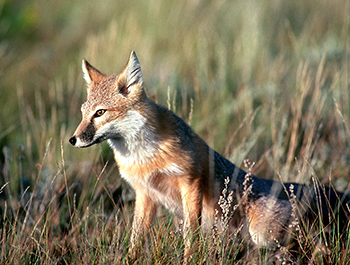
This case study examines the reintroduction and subsequent recovery of swift foxes in southern Alberta and Saskatchewan. The swift fox (Fig. 11.18) is a grassland species that once ranged across the Canadian Prairies and the US Great Plains (Pruss et al. 2008). Populations underwent precipitous declines in the late 1800s with the influx of Europeans to the West (Sovada et al. 2009). One of the main factors responsible for the decline was trapping. According to Hudson Bay records, an average of 5,000 pelts were harvested each year in Canada in the 1870s. In addition, large numbers of foxes were killed through poisoning programs targeting wolves.
Swift foxes were also impacted by the ecological changes that accompanied the settling of the prairies (Herraro 2003; Sovada et al. 2009). With the disappearance of bison from the plains, scavenging opportunities for swift foxes were much reduced. The plains wolf also disappeared, leading to an increase in coyote populations which, in turn, became a major cause of swift fox mortality. Campaigns by ranchers and farmers to kill badgers and ground squirrels reduced the number of escape holes and denning sites. Finally, a large proportion of swift fox habitat was converted to cropland and pasture.
By 1900, reports of swift fox were rare in Canada and the northern US. The last Canadian sighting was made near Manyberries, Alberta, in 1938. In 1978, the swift fox was officially designated as extirpated in Canada. Populations in the US persisted.
Reintroduction Program
The reintroduction of swift foxes into Canada began with preliminary breeding efforts at the Alberta Game Park and the Calgary Zoo in the 1960s (Carbyn 1998). A more formal project got underway in 1972, when Miles and Beryl Smeeton established what is now known as the Cochrane Ecological Institute, near Calgary, and imported two pairs of swift foxes under permit from Colorado (Smeeton and Weagle 2000).
The Smeetons collaborated with Steven Herrero, at the University of Calgary, which led to a series of graduate student research studies. The initial studies examined the political and public acceptability of swift fox reintroduction and rated the suitability of possible reintroduction sites (Herrero et al. 1986). The question of whether it would be better to use imported wild-born foxes from the US for the reintroduction, rather than captive-reared animals, was studied as well. Attention was also given to release methodology, post-release monitoring, and funding sources.
The Canadian Wildlife Service became formally involved in the project in 1978, after COSEWIC designated the swift fox as extirpated in Canada. A few years later, the Alberta and Saskatchewan governments became formally involved as well, and the initiative transitioned to an inter-agency cooperative program. This brought additional funding and expertise and provided local jurisdictional oversight.
Fox releases began in 1983 and continued until 1997. The releases occurred within the core of the historical Canadian range, in two main areas: one centred on the border between Alberta and Saskatchewan, and the other in south-central Saskatchewan (Fig. 11.19). A total of 932 foxes were released. Of these, 841 were reared in the Smeeton facility—the descendants of 17 wild pairs from Colorado, Wyoming, and South Dakota (Smeeton and Weagle 2000). The remaining 91 releases were wild foxes obtained from Colorado and Wyoming.
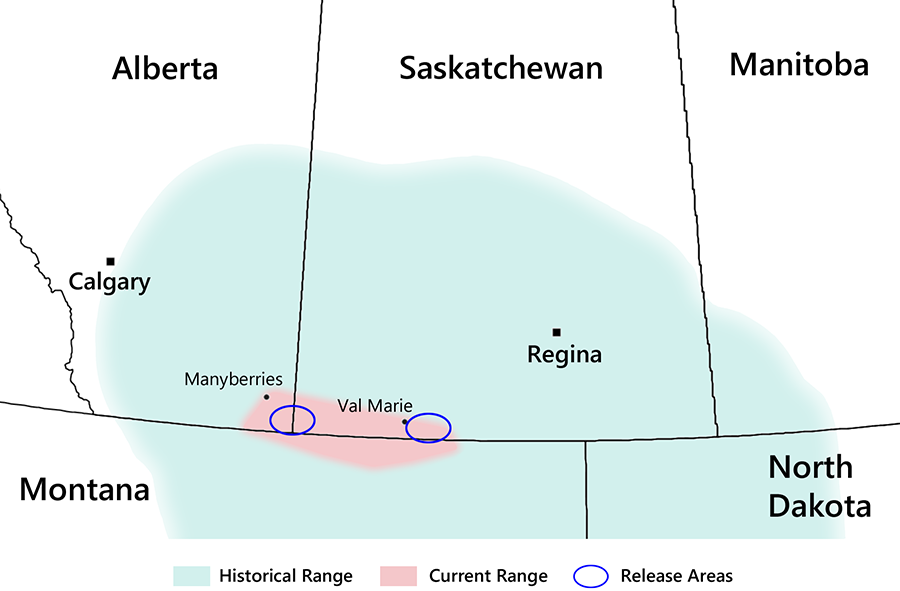
A second project began in 2004, with the aim of reintroducing swift foxes on the traditional territory of the Blood Tribe in southern Alberta (Pruss et al. 2008). Fifteen foxes were released in the first year, but the project was then discontinued because of a lack of funding.
A major concern for the reintroduction team was maintaining genetic diversity. Therefore, the source animals for the breeding operation were collected from several different US populations (Herrero et al. 1986). Breeding was carefully controlled to minimize inbreeding. Also, animals from the same bloodlines were not repeatedly reintroduced into the same geographic area (Smeeton and Weagle 2000). Outbreeding depression from the mixing of diverse genotypes was an acknowledged concern but did not seem to affect breeding success at the Smeeton facility (Herrero et al. 1986). There was also a concern that the source animals may lack the genetic adaptations needed to thrive in a Canadian climate. Since no local populations were available to use as source stock, this risk was accepted as one of the many uncontrollable factors inherent in the reintroduction.
Most aspects of the reintroduction program employed an adaptive management approach. This adaptive process did not involve quantitative modelling or formal experimental design. Rather, it was a classic example of “learning by doing” that involved trying different approaches and determining which was most effective. The outcomes were mainly assessed in terms of the rate of survival of the released foxes. The management levers amenable to study included (Waters 2010):
- Source of released foxes (captive-reared vs. wild)
- Location of release (considering variations in local terrain and vegetation)
- Timing of release (spring vs. fall)
- Age at release (juvenile vs. adult)
- Release method (soft, hard, intermediate)
The reintroduced fox population quickly grew and spread beyond the initial release areas, including into northern Montana. Thus, the reintroduction was considered a success. Swift foxes were downlisted from Extirpated to Endangered in 1999 and subsequently from Endangered to Threatened in 2012.
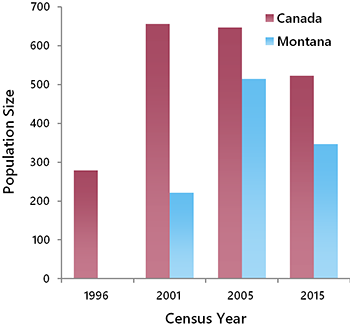
In the most recent field survey, in 2015, a population decline was observed instead of continued growth (Fig. 11.20). Managers have not been able to pinpoint the cause of this decline. The winter of 2010/2011 was particularly severe, and this may have been a contributing factor (Moehrenschlager and Moehrenschlager 2018). It is also possible that the population has reached a plateau. The region’s carrying capacity for swift foxes is not known, but it is certainly much lower today than it was in the past (Herraro 2003).
Multi-Species Action Planning
The federal swift fox recovery strategy was not completed until 2008, well after the reintroduction took place (Pruss et al. 2008). The stated recovery goal was to “restore a self-sustaining swift fox population of 1,000 or more mature, reproducing foxes that does not experience greater than a 30% population reduction in any 10-year period” (Pruss et al. 2008, p. 11). In terms of recovery actions, the strategy emphasized research, reflecting the limited state of knowledge about the species. The main threats to swift foxes were known, but the extent to which these threats would impair their recovery was unclear.
One of the research priorities was to identify critical habitat, an element missing from the recovery strategy. Other topics included the impacts of anthropogenic landscape disturbances and the biotic interrelationships between swift foxes, coyotes, and red foxes. The strategy also called for ongoing monitoring.
As far as actual management interventions, the strategy recommended that best practices for landowners be developed and disseminated through an outreach program. Swift fox recovery efforts were also to be integrated into a larger, unified conservation program for southern prairie species. This latter recommendation was realized in 2017, with the release of the Action Plan for Multiple Species at Risk in Southwestern Saskatchewan: South of the Divide (ECCC 2017b).
The multi-species action plan applied to nine species at risk and four species of special concern in southwestern Saskatchewan, including the swift fox. Compared with the swift fox recovery strategy, the multi-species action plan emphasized management action over research. The proposed activities included:
- Develop and implement grazing systems that provide high-quality habitat for species at risk
- Provide incentives to support targeted conversion of cropland and tame pasture to native grasses and shrubs
- Develop and encourage integrated pest management
- Develop an approach for infrastructure development that reduces disturbance and accidental mortality to species at risk
- Manage fire in ways that benefit species at risk without threatening infrastructure and agricultural values
- Investigate the utility of conservation agreements to protect critical habitat
- Conduct outreach to help landowners reduce the environmental impacts of their activities
The multi-species action plan also partially identified critical habitat for all species at risk. For the swift fox, critical habitat was identified using a spatially-explicit habitat suitability model (ECCC 2017b). This statistical model linked swift fox habitat use, derived from a population survey in 2005, with 14 landscape-scale habitat variables, obtained from remote sensing data. The reliability of the model was verified by comparing its predictions against three separate population surveys that had not been used for model development. Critical habitat was defined as all areas within the planning region that were expected to support swift foxes based on modelling extrapolations. This amounted to approximately half of the current swift fox range in Saskatchewan. In contrast to caribou, population persistence was not taken into consideration, mainly because no population model was available.
A shortcoming of the multi-species action plan was that it gave little consideration to implementation—it was mainly a shopping list of potential actions. This deficiency was addressed in a subsequent planning exercise which used a structured decision-making approach to define implementation priorities (Martin et al. 2018; Carwardine et al. 2019). In this exercise, the various strategies listed in the multi-species action plan were treated as management alternatives to be assessed and compared. The goal was to identify the strategy, or combination of strategies, that maximized overall species recovery, taking the expected benefit, cost, and feasibility of each strategy into account.
In the decision analysis, the benefit of a given strategy was expressed as the probability of achieving the recovery objectives for each species (calculated for each species individually and then summed across all species). The cost of a strategy was the total cost of all individual actions as well as the value of foregone development opportunities. The overall feasibility was defined as the probability that the action would be implemented (given socio-political considerations) multiplied by the probability of success (given methodological and logistical limitations). All assessments were based on a 20-year time horizon.
The information required for the assessments was elicited from a group of experts using a structured Delphi approach during an intensive three-day workshop. The group was composed of nine grassland ecosystem experts from government agencies and universities. Many of these experts were contributors to the original multi-species action plan. To gauge uncertainty, the experts were asked to provide their best guess for each parameter as well as estimates of upper and lower bounds.
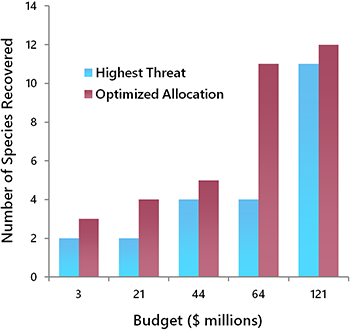
Once the required information had been assembled, the planners used linear programming to identify the optimal management approach. “Optimal” was defined as the strategy (or combination of strategies) that maximized the number of species that achieved a specified level of recovery success while minimizing the total cost. The team found that, for most budgets, optimal resource allocation provided better conservation outcomes than the common approach of prioritizing the most threatened species (Fig. 11.21). The size of the conservation budget had an overriding effect on the number of species recovered.
A limitation of the optimization exercise was that quantitative data were generally lacking; therefore, the assessments had to be based on expert opinion. Some of the estimates, particularly those regarding feasibility, were essentially informed guesses. Moreover, some management options were excluded from consideration altogether because of knowledge gaps. Thus, the results are best thought of as hypotheses that reflect the current state of knowledge.
Analysis and Conclusions
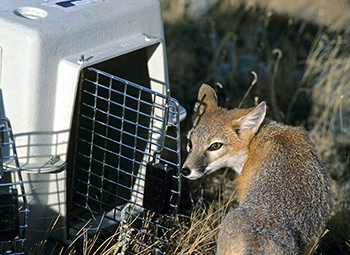
The reestablishment of swift foxes in Canada stands as a major accomplishment. Credit goes to the conservation practitioners whose dedication and determination made the reintroduction happen. Credit also goes to the swift fox, whose adaptability and high reproductive capacity allowed it to grow despite profound alterations of the prairie landscape (the point being that we cannot expect similar outcomes with all species at risk).
The dip in population size observed in the 2015 survey is a point of concern and suggests that the recovery of the swift fox is not yet assured. This decline may just be a weather-related fluctuation, but it is also possible that the carrying capacity of the current prairie ecosystem is relatively low. If the latter, then the future trajectory of swift fox recovery may depend on the extent to which the ecological integrity of the southern prairies can be restored. Saskatchewan’s recent policy decision to privatize its rangelands (CWF 2017) will likely make this more difficult. On the other hand, the formal identification of critical habitat in the federal action plan means that habitat protection will now be a legal requirement.
This case study illustrates the convoluted path that conservation initiatives sometimes follow. At different stages, the reintroduction program was a private venture, a University of Calgary research project, an inter-agency cooperative initiative, and a component of the national species recovery program. A project like this takes shape when a few key individuals become convinced of its merit and provide the drive and determination to move it forward. These leaders attract others to the project, and the necessary resources are then collectively assembled. The lesson here is that conservation is sometimes a bottom-up process, dependent on individual initiative, rather than a top-down, policy-driven process.
Because the reintroduction of the swift fox posed no threat to farming or ranching operations, it encountered little opposition. Nor did the program have a high public or political profile. This was an example of the biocentric model of conservation in action, where scientific problem solving predominated. There was a single, clear objective—swift fox reestablishment—and decisions were largely data driven and relied heavily on structured learning.
After the reintroduction program ended, in 1997, the emphasis of management shifted to ensuring long-term persistence. However, there was uncertainty about what needed to be done. Moreover, there was a lack of clarity about what the recovery objectives should be, beyond basic population survival. Federal policy describing the full spectrum of recovery objectives was not provided until 2016 (ECCC 2020). As a result, the 2008 recovery strategy emphasized research and prescribed little management action.
As the recovery process evolved, the social dimension of conservation became increasingly important. Most of the proposed conservation measures in the 2017 multi-species action plan entailed changes to land-use practices, especially agriculture. This meant that the support and cooperation of land users was required, in contrast to the initial reintroduction phase.
The extension of recovery planning to multiple species, through the multi-species action plan, was an important step. It raised the profile of regional conservation needs, facilitated conservation synergies, and increased overall planning efficiency. In contrast to the 2008 recovery strategy, the action plan emphasized management actions over research. However, it still failed to meaningfully consider implementation. This gap was later addressed through an optimization exercise that identified management priorities, taking costs and feasibility into account. Together, the action plan, which identified strategies, and the optimization exercise, which identified priorities, provide a useful template for future recovery planning efforts.
When the optimization study was released in 2018, the headline it generated in the Globe and Mail newspaper was: “Too expensive to save? Why the best way to protect endangered species could mean letting some go” (Semeniuk 2018). The message the media latched onto, presumably because of its shock value, was that we must allow some species to become extirpated in order to ensure the viability of others—a classic triage interpretation. This reflects a misunderstanding of what the optimization initiative was meant to accomplish.
The aim of the optimization exercise was to identify management strategies that provided the greatest overall conservation gain within the study area, for any given conservation budget. The process did not pit one species against another. Instead, it was concerned with the effectiveness of individual management actions, giving preference to actions that benefited multiple species over actions that provided narrow benefits.
Notably, the optimization exercise did not try to determine how large the conservation budget should be (or, by extension, how many species had to be “let go”). The determination of what society is willing to pay for maintaining species at risk is not something that can be addressed by a group of technical experts at a workshop. Such decisions are inherently political because they entail finding an acceptable balance among competing social objectives.
The way that optimization exercises feed into the broader political dimension of conservation is by drawing attention to conservation needs. A graph like Fig. 11.21 vividly illustrates the conservation consequences of inadequate conservation funding, making trade-offs explicit. This provides a useful foundation for public dialog about land use. Moreover, by framing the debate in terms of the collective needs of a large suite of species at risk, the case for conservation is considerably enhanced.
In summary, optimal resource allocation should be used to ensure that existing conservation resources are used as effectively as possible. It is also vital to expand the resources that are available—it is not just how we slice the pie, but the size of the pie that is important. This requires public outreach to raise awareness of conservation issues and to draw attention to funding shortfalls. It also requires engagement at higher levels of the decision hierarchy, where budgets are determined.

